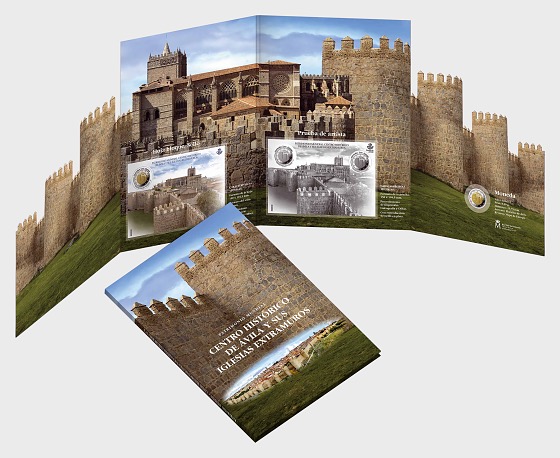2019World Heritage - Ávila - Special Folder
2019 World Heritage - Ávila - Special Folder for only GBP £25.86

- 27.03.2019
- -
- -
- -
- Engraving & offset
- -
- 150 x 104.5 mm
- €5.20
This year Ávila is the star of the World Heritage series with a mini sheet and a stamp depicting a coin which will also be brought into circulation.
The engraving on the coin represents a tower from the city walls of Ávila, one of the town's most famous features.
The stamp is framed by a magnificent chalcography of a detail of the city, showing part of the city walls and some of its most iconic buildings, such as the cathedral of Cristo Salvador.
In 1985 Ávila became a UNESCO World Heritage City, in part for the excellent conservation of its buildings, as a superb example of a fortified city, for its many civil monuments, and as “an outstanding example of a type of building, architectural or technological ensemble or landscape which illustrates a significant stage in human history...”.
Ávila is located on the river Adaja and is the highest-altitude province in Spain at 1,131 meters above sea level.
But Ávila is famous above all for its complete medieval city wall, in the Romanesque style, with parapet walks along almost its entire length.
Its medieval city center is also very well preserved, making a stroll around its streets something of a time travel experience.
Its famous sweet, Yemas de Santa Teresa, its excellent meat dishes and its patatas revolconas (a hearty potato dish) invite visitors to sample its culinary traditions, making the city an even more attractive destination.
Each year, Correos issues a stamp in this series of the World Heritage Sites of Spain.
Stamps and coins can travel around the world, making them tiny, portable showcases for the countries which issue them, and this year Ávila will be traveling with them.
Carmen Alvarez Casanova
Spain - Recommended stamp issues
WOPA+ recommended stamp issues
| Effigy of H.S.H Prince Albert II - Green Letter Rate |
| Issued: 03.01.2023 |
| ›Monaco |
| Year of the Rabbit |
| Issued: 05.01.2023 |
| ›Guernsey |
| Medicinal Plants |
| Issued: 03.01.2023 |
| ›Romania |
| Honour Guard of the President of the Slovak Republic |
| Issued: 02.01.2023 |
| ›Slovakia |
| Veteran Tractors |
| Issued: 04.01.2023 |
| ›Aland Islands |
| Lunar New Year - Year of the Rabbit |
| Issued: 05.01.2023 |
| ›Jersey |
| Dimitrie Cantemir, 350th Anniversary of his Birth |
| Issued: 16.01.2023 |
| ›Romania |
| St. Elizabeth’s Church in Parnu |
| Issued: 06.01.2023 |
| ›Estonia |
| Music Giants VII - Iron Maiden |
| Issued: 12.01.2023 |
| ›Great Britain |
























